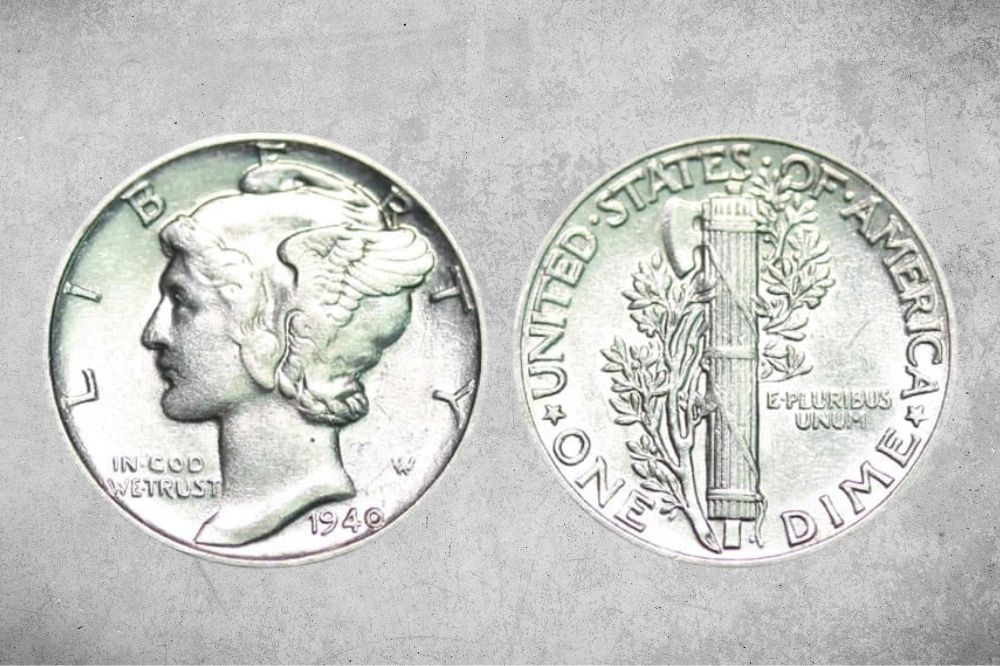Many people refer to the 1940 dime as the “Mercury” dime. But did you know that Mercury, the god of commerce, isn’t actually on the coin? Instead, the lovely face on it belongs to a young Lady Liberty.
Despite the confusion on who is on this coin, the 1940 dime remains to be one of the most beautiful, sought-after coins in US mintage—even if they’re not as expensive as other, older coins.
But how much is the true value of a 1940 dime? Can you sell a 1940 dime regardless of its mint mark? What errors should one look out for, and how do they affect the price of the coin? Today, we’ll delve into all of that and more. Stick around to learn more about the 1940 dime.
1940 Dime Value Details
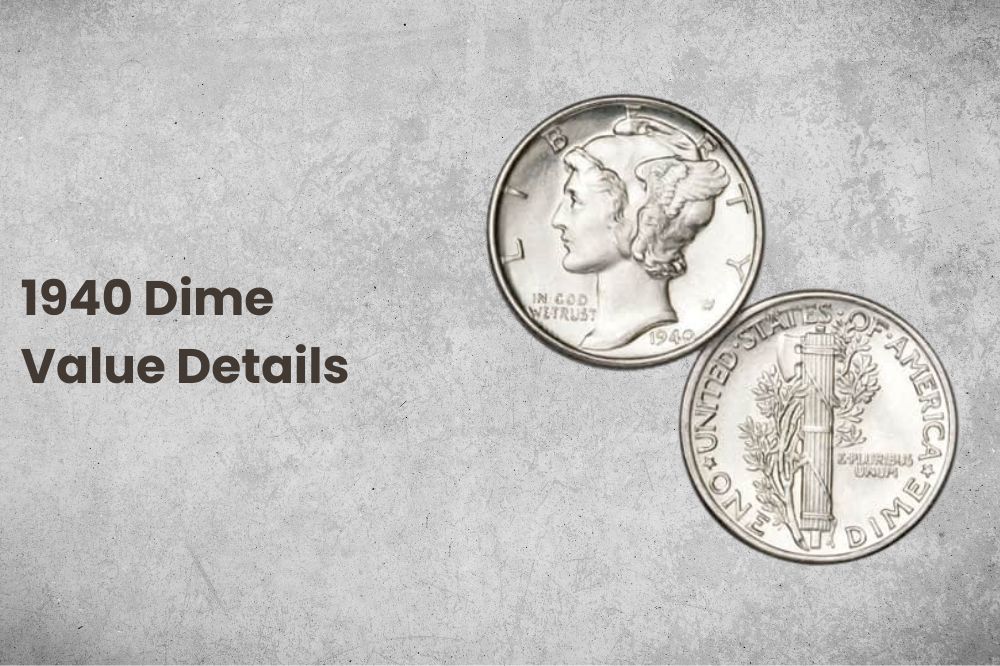
- Category: Mercury Dimes
- Mints: Philadelphia, Denver, and San Francisco
- Total mintage: 108,108,000
- Obverse designer: Adolph A. Weinman
- Reverse designer: Adolph A. Weinman
- Edge: Reeded
- Diameter: 17.8 mm
- Content: 90% silver, 10% copper
- Melt value: $1.52 (as of March 2023)
- Weight: 2.5 grams
In 1940, a year before the war was set to begin, the US minted over 100 million Mercury dimes. It was made of silver, making them quite valuable given their modern melt value alone.
But what makes a 1940 dime special? Let’s take a look at the features you can find on this crowd-favorite coin.
1940 Dime Design
On the obverse of the coin is the side profile of Lady Liberty facing left. She’s wearing a Phrygian cap with little wings on them.
The Phrygian cap—also known as a liberty cap—is a symbol of freedom. In Ancient Rome, slaves that were finally freed from their oppressors would wear such a cap to indicate their liberty. It’s the perfect cap for what Lady Liberty and America stand for.
All around the rim of the coin are the letters that spell “LIBERTY.” Right below Lady Liberty’s chin is the words “In God We Trust,” and right below her truncated neck, the year 1940. At around five o’clock, the designer’s initials, “AW” are written.
Meanwhile, on the reverse, you’ll notice a “fasces,” aka a bundle of rods with a sharp axe tied to its upper area. You’ll see a couple of olive branches around it. What’s interesting is that this design shows power and firmness, but also alludes to America’s ideals of liberty and peace.
On the right side of the fasces is the American creed “E pluribus unum.” On the rim of the reverse are the words “United States of America” and “One Dime.”
Full Bands Designation
1940 Mercury dimes are already of great value today. But aside from its silver content and beautiful design, there’s another factor that makes this dime more valuable—a Full Bands designation.
On the fasces, or bundle of rods, on the reverse of the coin, you’ll notice some bands tying all the sticks together. If the bands are split into two with a bold, distinct, uninterrupted line for all three sets, it’s given a Full Bands designation, increasing its value.
Also Read: Top 15 Most Valuable Indian Head Penny Worth Money
1940 Dime Value Chart
| 1940 Dime Value Chart | ||||||
| Mint Mark | Good | Very Fine | AU58 About Uncirculated | MS62 Uncirculated | MS66 Gem Uncirculated | MS68 Superb Gem Uncirculated |
| 1940 Dime Value for No Mint Mark (P) | $3 | $3.45 | $4.50 | $9
Full Bands: $12.50 |
$40
Full Bands: $75 |
$370
Full Bands: $2,450 |
| 1940 Dime Value for “D” Mint Mark | $3 | $4 | $5 | $12
Full Bands: $15 |
$45
Full Bands: $70 |
$700
Full Bands: $1,250 |
| 1940 Dime Value for “S” Mint Mark | $3 | $4 | $5 | $12.50
Full Bands: $17.50 |
$50
Full Bands: $145 |
$700
Full Bands: $5,000 |
1940 Dime Values and Varieties Guides
1940 Dime Value for No Mint Mark (P)
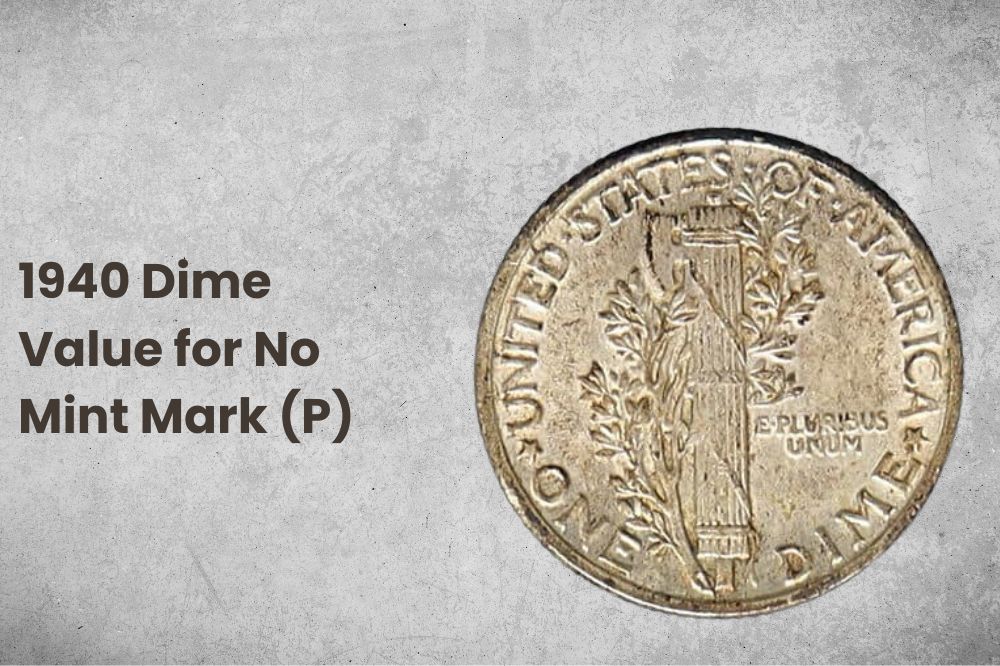
- Type: Mercury Dimes
- Edge: Reeded
- Mint mark: No mint mark (P)
- Place of minting: Philadelphia
- Year of minting: 1940
- Face value: $0.10
- $ price: $2.50 to $370; up to $2450 for Full Bands
- Quantity produced: 65,350,000
- Designer: Adolph A. Weinman
In 1940, the Philadelphia Mint struck 65.3 million Mercury dimes—the highest number at any mint that year by a mile. And as with all large mintages, there was an overuse in the dies, resulting in a large chunk of the coins lacking bold, distinct lines on the design.
In heavily worn, circulated condition, you can expect the value of this coin to go from $2.50 to $4.75. But in uncirculated conditions, you can sell these pieces for at least $7 (MS60). A superb gem can reach a high price like $370 at a glittering grade MS68.
Because there were so many coins struck in Philly that year, the issue is quite common and easy to look for. It’s even plentiful in mint-state conditions and Full Band variants.
Of course, just because there are many mint-state 1940 (P) dimes in existence, it doesn’t mean they’re not valuable. They can still sell for a huge amount, especially with that coveted Full Bands designation.
The most affordable 1940 (P) dime with Full Bands you might find is an MS60, which is valued at $8.50. This doesn’t sound like a lot, but the price increases depending on the coin grade. At MS67, a dime with Full Bands will be valued at $170, and at MS68, a whopping $2,450.
1940 Dime Value for “D” Mint Mark
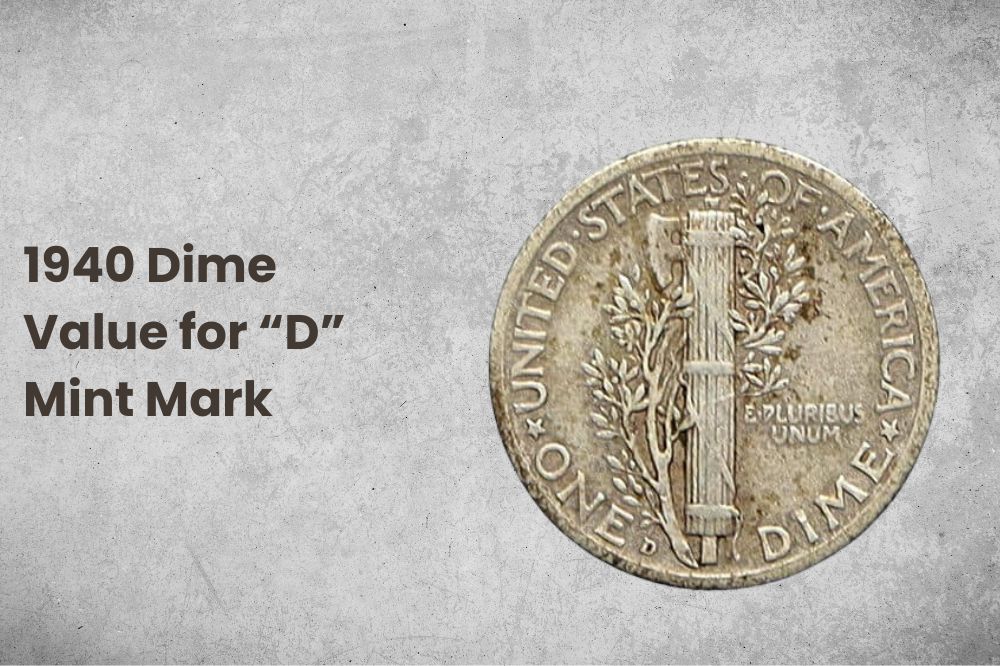
- Type: Mercury Dimes
- Edge: Reeded
- Mint mark: D
- Place of minting: Denver
- Year of minting: 1940
- Face value: $0.10
- $ price: $2.50 to $700; up to $1,250 for Full Bands
- Quantity produced: 21,198,000
- Designer: Adolph A. Weinman
The Denver Mint had the lowest mintage of the Mercury dime in 1940; the San Francisco Mint produced a higher number by a hair.
Because they’re relatively scarcer than the Philadelphia-minted dimes of that year, the 1940 D dimes are more valuable across all grades today.
Circulated coins can go anywhere between $2.50 (poor or average condition) to $5 (AU58). This price shoots up in the lower mint-state grades. At MS60, a 1940 D Mercury dime might cost around $8. For an MS63 variant, on the other hand, you could be looking at almost $15.
Like many coins minted in the 1940s, the Denver dimes were the most consistently well-struck. So, you can find tons of gem uncirculated coins of this issue, specifically through grades MS65 to MS67. They also have a lot of coins awarded with the Full Bands designation.
An MS66 1940 D dime is worth about $45. But with a Full Bands designation, the price goes up to $70. The price increase with Full Bands is even starker with an MS68 coin, which normally goes for $700 but can be sold for $1,250 if it had Full Bands.
1940 Dime Value for “S” Mint Mark
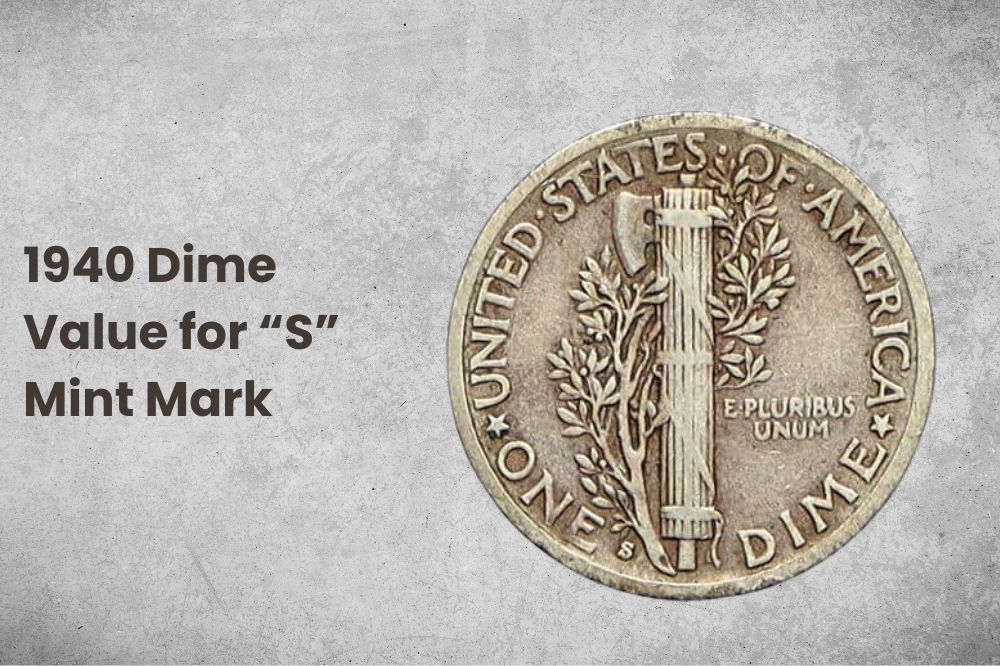
- Type: Mercury Dimes
- Edge: Reeded
- Mint mark: S
- Place of minting: San Francisco
- Year of minting: 1940
- Face value: $0.10
- $ price: $2.50 to $700; up to $5,000 for Full Bands
- Quantity produced: 21,560,000
- Designer: Adolph A. Weinman
This year, the San Francisco Mint made the highest number of dimes it ever did since 1917. In 1941, however, the mint had gone back to creating fewer dimes there, as America was set to enter the war.
Because the 1940 S dimes were created in almost the same quantity as the Denver-minted dimes, they go for similar prices for the regular strike coins—even those in mint state. The prices are quite similar from circulated coins ($2.50 to $5) to uncirculated gems ($8.50 to $700).
But for coins with Full Bands, the San Francisco issues are the most valuable of the three. An MS67 dime with distinct bands in the fasces has a value of around $550. At an even higher grade of MS68, you can expect a Full Bands 1940 S coin to reach an awesome value of $5,000.
1940 S Mercury dimes are known for their high luster and proof-like appearance. This might be because of the aggressive repolishing of the dies at the San Francisco Mint to remove erosion marks on the machine. It’s one reason why there were tons of Full Band dimes made here.
History of the 1940 Dime
In the 1910s, a competition was held between three designers—Albin Polasek, Hermon A. MacNeil, and Adolph A. Weinman—to see who could make the best, most aesthetically beautiful designs for three upcoming coins that featured Lady Liberty.
Weinman, a student of the great Augustus Saint-Gaudens, poured his heart and soul into the contest. He eventually snagged two out of the three coins up for grabs—the half dollar, as well as what is now known as the Mercury dime.
The dime was an excellent replacement for its predecessor, the outdated and rigid Barber dime. This new dime was loved by many for its eye appeal and how it tells the story of liberty and peace—modern ideals that America was starting to own.
Over 100 million dimes were produced in 1940, the year before America was to enter World War II. Finally, in 1945, the Mercury dime took its final bow at the mints, soon to be replaced with the FDR dime to honor the great president’s legacy and contributions during the war.
Also Read: Top 15 Most Valuable Roosevelt Dimes Worth Money
1940 Dime Grading
Like all coins, the true value of a 1940 dime depends on its condition. And while it takes a professional with lots of grading experience to pinpoint the exact grade of your coin, you can also assess your 1940 dimes to get an idea of how much it would cost to sell.
Here are some tips for checking whether your 1940 can pass for a mint-state condition:
- Tilt the coin directly under a light. If it has immense shine and luster, it might be mint-state.
- Look at the high points for heavy wear. This includes Lady Liberty’s forehead and the bands on the fasces. The less worn a coin, the more valuable.
- Make sure there isn’t evident smoothing near busy areas of the design, like the olive branches and bands on the obverse.
As always, it’s best to refer to a coin grading video guide when checking on your coin’s condition. Here’s a Mercury dime coin grading how-to guide:
1940 Dime Errors
1. 1940 Dime Uncentered Broadstrike Error
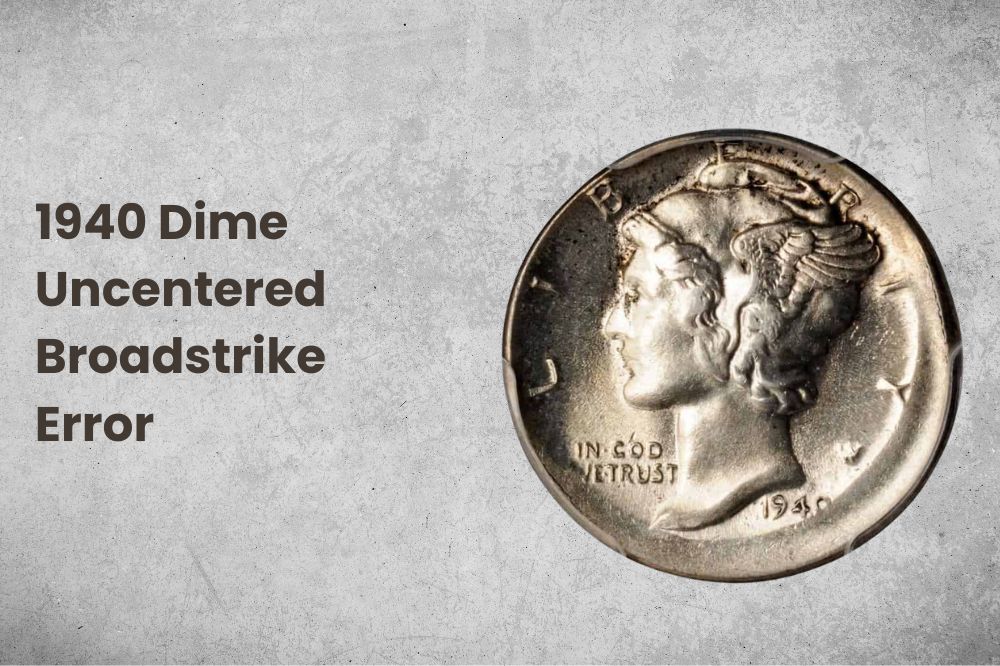
In 2014, an MS62 1940 dime sold for $90, even if its value at that grade should have been just $9. This is because it had an uncentered broadstrike error, which means it was struck out of the collar in the mint.
As a result, the design is uncentered on the planchet. It also leaves out a big chunk of blank space on the outer edges of the coin.
2. 1940 Dime Repunched Mint Mark Error
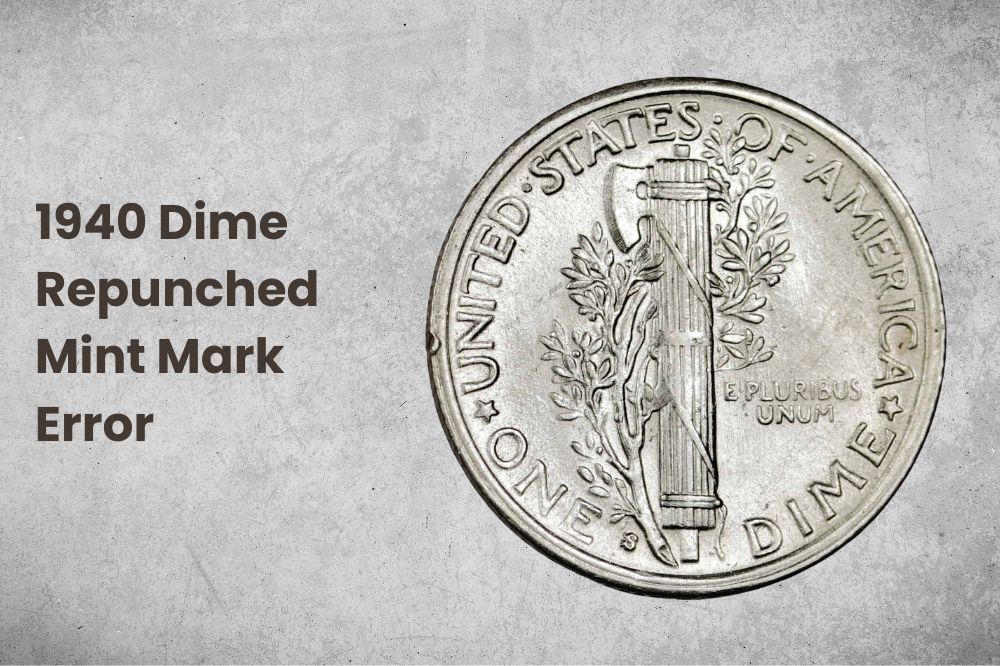
A common error found in both Denver- and San Francisco-minted 1940 dimes is the repunched mint mark. Take a microscope and put your coin under it. If you see that the mint mark was struck twice—one on top of the other—you have yourself a coin with a repunched mint mark.
3. 1940 S Dime Doubled Die Obverse Error
Sometimes, a coin will be struck twice by a die. This is usually because the planchet was not ejected properly after the first strike. As a result, you’ll see a faint double image on the coin.
This error has been found on a 1940 S dime’s obverse. At MS65, it sold for $48—not that expensive, but still a unique, interesting piece to own and put in your collection.
Watch this interesting video by Couch Collectibles to see what these errors look like, as well as some examples of rare Full Bands varieties on the 1940 Mercury dime:
1940 Dime FAQs
How rare is a 1940 dime?
With over a hundred million Mercury dimes produced in 1940, this issue of the beloved dime design isn’t exactly rare. On the contrary, it’s plentiful and easy to look for across all grades—even those in mint-state condition.
Is a 1940 dime silver?
Yes, across all the years the Mercury dime was minted (1916-1945), its composition of 90% silver and 10% copper remained the same. This includes the 1940 issue of the dime.
What dime is worth millions?
Not many dimes are valued at millions of dollars. Perhaps the most prized dime in US mintage history is the 1894-S Barber dime. Only 24 of its kind were minted as proofs, and so they can go up to $1.7 million when sold today, over a century since their mintage.
